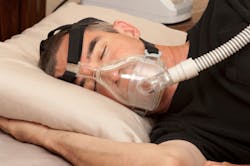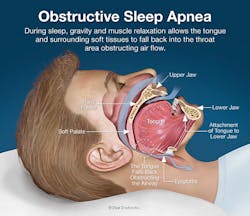The U.S. Department of Transportation has taken the “first step” to address obstructive sleep apnea (OSA) in truck drivers.
The Federal Motor Carrier Safety Administration (FMCSA) and Federal Railroad Administration (FRA) on Thursday will jointly publish an Advance Notice of Proposed Rulemaking (ANPRM) that calls for public input during the next 90 days on the impacts of screening, evaluating, and treating commercial drivers and rail workers for OSA.
The National Transportation Safety Board has recommended that DOT take action to address OSA screening and treatment for transportation workers, placing “require medical fitness for duty” on its Most Wanted List of transportation safety improvements for 2016.
The pre-publication copy of the DOT proposal cites several sleep apnea-related incidents investigated by NTSB, including a July 2000 work zone accident in which a tractor-trailer driver collided with a Tennessee Highway Patrol vehicle trailing construction vehicles, killing the state trooper inside. The tractor-trailer driver was 5 feet 11 inches tall, weighed 358 pounds, and had been diagnosed with and undergone surgery for OSA, but had not indicated either the diagnosis or the surgery on examinations for medical certification, according to the investigation report.
The notice also points to recent rail accidents attributed to sleep apnea, including the December 2013 commuter train derailment that killed 4 and injured more than 60 in New York City.
FMCSA and FRA will host three public listening sessions to gather input on OSA in Washington, Chicago, and Los Angeles as both agencies consider whether to propose requirements specifically on OSA.
“The collection and analysis of sound data on the impact of OSA must be our immediate first step,” said FMCSA Acting Administrator Scott Darling. “We call upon the public to help us better understand the prevalence of OSA among commercial truck and bus drivers, as well as the safety and economic impacts on the truck and bus industries.”
Trucking industry groups are taking a wait-and-see position on the proposal.
“We’re pleased that DOT is taking the time to solicit input and data from the industry and the public on this important safety issue because we believe regulations—including one that might possibly address obstructive sleep apnea—should be based upon sound data and analysis,” American Trucking Assns. spokesman Sean McNally said. “In particular, DOT needs to understand the scope of the problem, the number of crashes that directly result from sleep apnea, and determine if there is a need for a solution that can improve safety, but in a way that is both effective and cost-beneficial to drivers and fleets.”
The Owner-Operator Independent Drivers Assn. was still reviewing the notice when contacted by Fleet Owner.
“We have always encouraged our members to seek medical advice from their personal physicians regarding all health issues,” OOIDA spokesman Norita Taylor said.
1 in 5 truckers afflicted
According to the American Academy of Sleep Medicine, federal rules currently provide insufficient guidance for medical examiners and sleep specialists in the diagnosis, evaluation and ongoing management of sleep apnea among transportation operators.
“Sensible, evidence-based management plans have great potential to improve the health of commercial motor vehicle drivers and train operators while reducing the devastating accidents that can result from untreated sleep apnea,” said AASM President Dr. Nathaniel Watson. “The comprehensive development and swift implementation of evidence-based sleep apnea policies is necessary to protect the well-being of transportation operators and maximize public safety.”
OSA is a chronic disease that afflicts at least 25 million adults in the U.S., including more than 20 percent of commercial truck drivers, AASM says. A frequent warning sign for sleep apnea is excessive daytime sleepiness, which can manifest as drowsy driving. It is estimated that 328,000 crashes on U.S. roads each year—including 6,400 fatal crashes—involve a drowsy driver.
The size and scope of the potential problem means that OSA “presents a critical safety issue” for all modes and operations in the transportation industry, DOT says.
For any truck drivers who are detected to have a respiratory dysfunction, such as OSA, FMCSA currently recommends that medical examiners (MEs) refer them for further evaluation and therapy. FMCSA has also taken steps to strengthen the screening and treatment process, and was prepared in early 2012 to move forward with regulatory guidance that set a Body-Mass Index (BMI) of 35 as the threshold for MEs screening drivers for referral to a specialist.
Some industry groups resisted the proposed guidance, however, and in 2013 Congress passed a law requiring FMCSA to undertake a complete rulemaking before issuing any new or revised requirement regarding sleep disorders.
In January 2015, FMCSA issued a bulletin to remind healthcare professionals on the agency’s National Registry of Certified Medical Examiners of the current physical qualifications standard and advisory criteria concerning the respiratory system, specifically how the requirements apply to drivers that may have obstructive sleep apnea.
To submit a comment online, go to www.regulations.gov and search for docket number FMCSA-2015–0419.
More information about obstructive sleep apnea is available at www.sleepeducation.org.
About the Author
Kevin Jones 1
Editor
Kevin has served as editor-in-chief of Trailer/Body Builders magazine since 2017—just the third editor in the magazine’s 60 years. He is also editorial director for Endeavor Business Media’s Commercial Vehicle group, which includes FleetOwner, Bulk Transporter, Refrigerated Transporter, American Trucker, and Fleet Maintenance magazines and websites.

